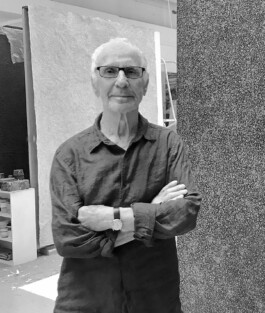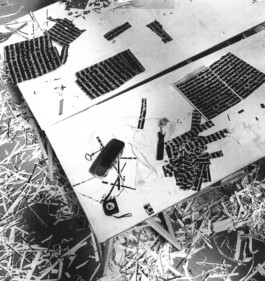
Bio
Max Wechsler
Born in 1925 in Berlin to a Jewish family, Max Wechsler was sent to Paris in January 1939. His parents, who stayed in Berlin, were deported.
At the end of the war, he chose to stay in Paris, working various jobs before beginning his career as an illustrator and graphic designer at the Vaillant newspaper, a part-time profession he would continue until the early 1990s.
In the 1950s, he began painting intensely, focusing on landscapes, portraits, and compositions inspired by his frequent visits to museums, where he immersed himself in the works of artists like Paul Klee and Jean Dubuffet. His first exhibition, featuring small, brightly coloured, saturated works, was held in 1959.
During the 1960s, Wechsler produced a significant body of surrealist work, "Compositions fantastiques", characterised by what Pierre Gaudibert described as "organic unfoldings... expansions of coils, swellings, fissures," and by A. Pacquement as "symbolic figures reflecting a work born of suffering." These pieces were exhibited at the Musée d’Art Moderne de la Ville de Paris during the ARC’s first event in 1968.
In 1973, Wechsler voluntarily ceased painting, only to resume in 1977.
Abandoning figuration permanently, he turned to abstraction, creating a series of works on canvas in which he explored matter through a new gestural approach: projections, striated surfaces, and slashing gestures.

In 1984, he initiated another radical shift. He abandoned the stretcher frame in favour of large-scale works on free-hanging canvas, incorporating collages of various materials—papers and newspapers—into dense, thick textures, which he titled "Recouvrements papiers" (Paper Overlays). These large formats were inspired by the spacious studio he acquired in 1985 in the Bastille district, where he worked until the end of his life.
In 1989, he befriended critic and poet Maurice Benhamou, marking the start of a long friendship and collaboration.
From 1990 onward, his creative process focused exclusively on printed material. Through reductions, enlargements, and extreme distortions of typographic characters, Wechsler transformed all kinds of writings to create a universe where only the memory of the letter remained.
This infinite reproduction process raised questions about the notion of series.
Expanding the boundaries of illegibility, his works shifted from deep black to luminous white, where light emerged from the material itself. According to Wechsler, this was "the other light, the one that emanates from the work." Only the sign bore witness to the permanence of the letter and its impossible disappearance.
These "Papiers Marouflés", ranging from very large to very small formats, were described by Dominique Dendraël as "overlays and successive layers [that] form an archaeology of memory."
Max Wechsler said: "The letter, continually transformed and deconstructed, resists, revealing itself to be indestructible... I associate what will forever remain unknown with what will remain indelible."
In the 2000s, Berlin welcomed the artist back to his birthplace with several significant exhibitions, including at the Jüdisches Museum Berlin, Villa Oppenheim, KunstbüroBerlin Galerie, and the Berlinische Galerie, to which he made a major donation in 2010.
In Paris, he exhibited regularly at the Musée d’Art et d’Histoire du Judaïsme, Galerie Guislain-États d’Art, Galerie ETC, and Galerie Dutko.
He created his final works in 2019 and passed away in Paris on 12 May 2020.
Major public acquisitions:
Musée Joseph Déchelette, Roanne
Musée d’art moderne et contemporain de Saint Etienne Métropole - MAMC+
Musée d’art moderne de la Ville de Paris - MAMVP
Musée des beaux-arts de Rennes
Musée National d'Art Moderne, Centre Pompidou
Musée du Hiéron, Paray-Le-Monial
Jüdisches Museum Berlin, Berlin
Berlinische Galerie, Berlin
KunstMuseum Liechtenstein
AXA - Caisse des Dépôts et Consignations, une collection pour la Grande Arche de la Défense
Fonds National d'Art Contemporain, Paris